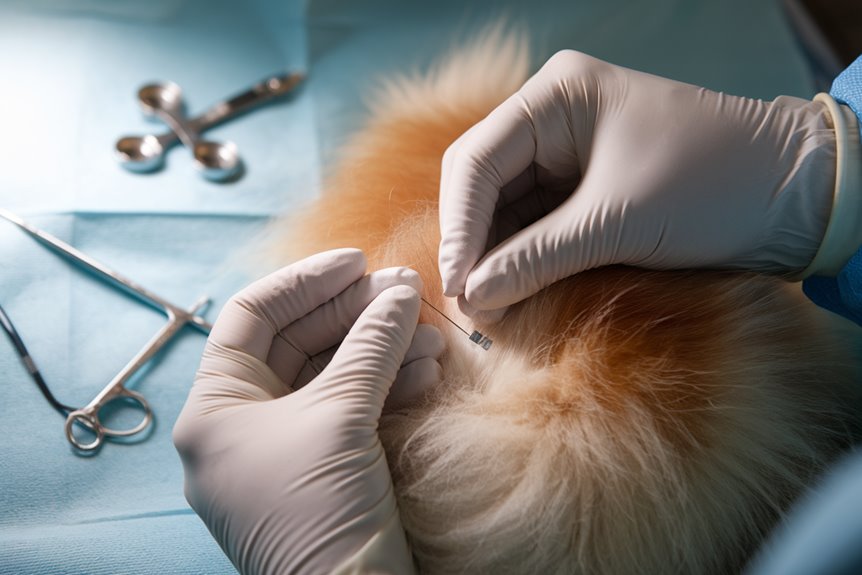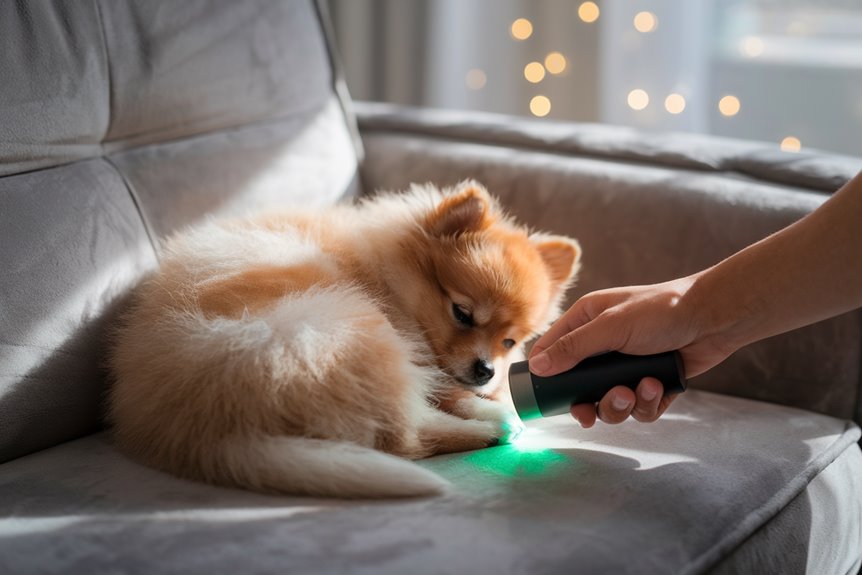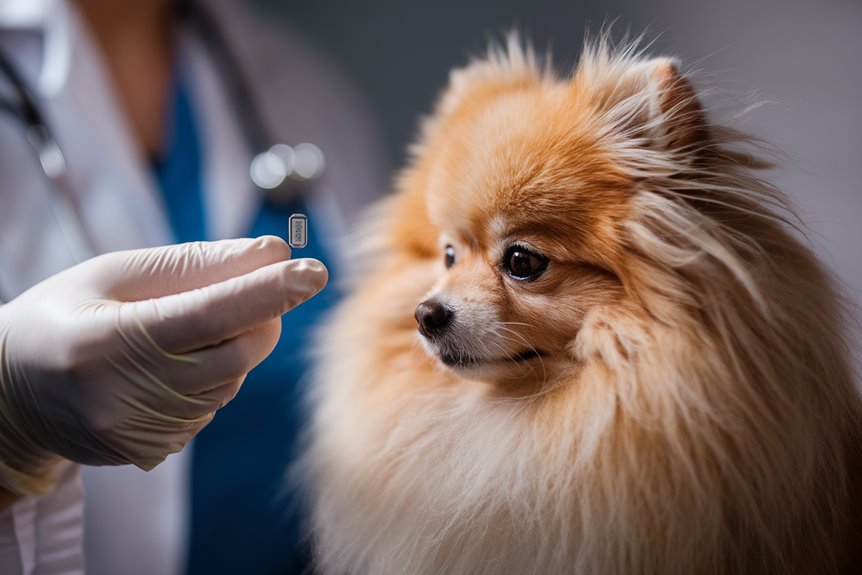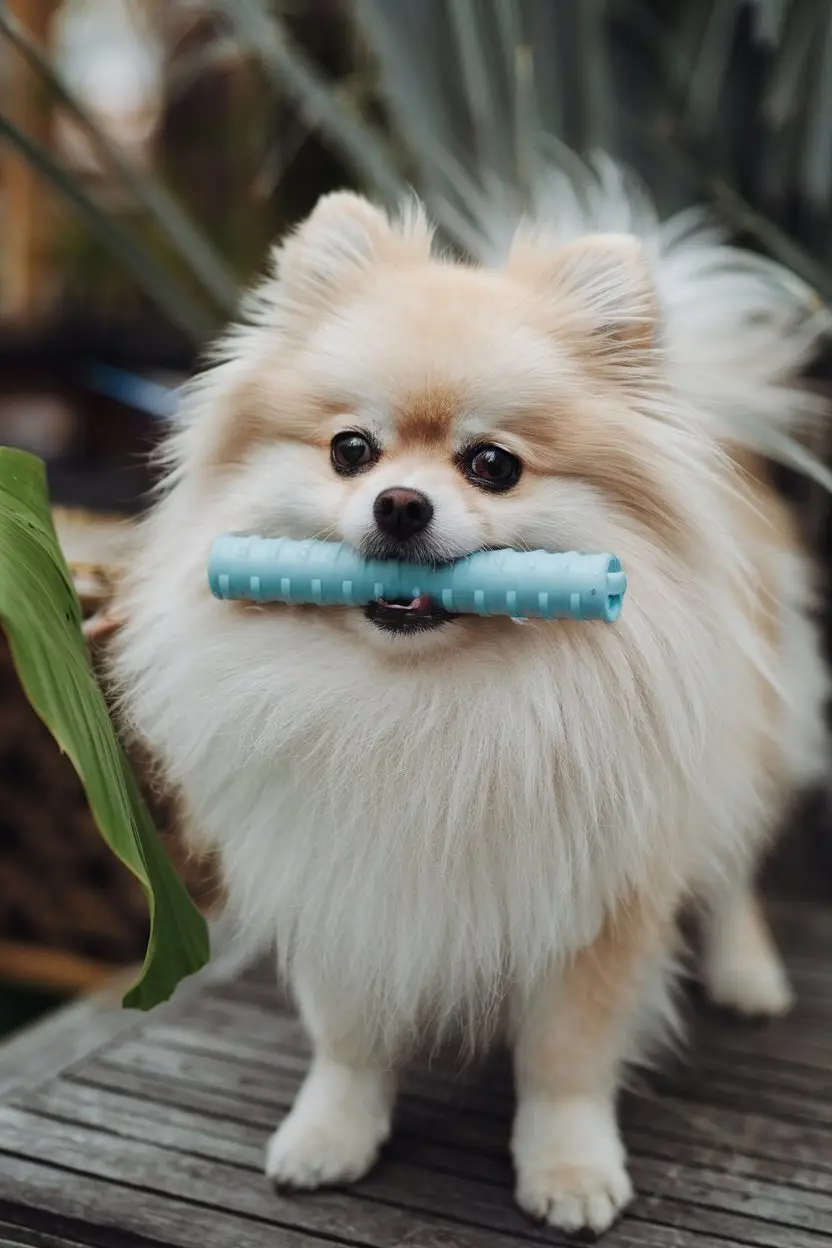Just think about how amazing microchipping your Pom can be! If your little fluffball ever decides to go on an adventure, they’re way more likely to find their way back home – like 2.4 times more likely!
For just $30-$50, you can get this tiny chip popped between their shoulder blades, and boom – your pup’s got a digital ID that sticks around forever, unlike those pesky collars that keep falling off.
Super easy stuff – you don’t even need to do anything with the chip after it’s in there, just get it checked once a year at the vet to make sure it’s doing its job. Yeah, there’s a tiny 6% chance of minor hiccups during the procedure, but honestly, it’s totally worth it for keeping your precious Pom safe and sound. This bit of tech does so much more than you’d think!
Understanding the Microchipping Process

The whole microchipping thing for your Pom is super simple and barely hurts at all. Your vet will pop a tiny chip right between your fur baby’s shoulder blades – it’s basically like getting a quick shot.
No need to knock your pup out for this, but they might get a bit of numbing cream to make it extra comfy.
Getting the chip in the right spot is super important, and today’s methods make that a breeze. Your vet will use a special needle to put it in, then do a quick scan to make sure everything’s good to go.
After that, you’ll just need to sign up with a pet recovery database and keep your phone number and address up to date.
While the chip won’t tell you where your pup is hanging out (it’s not GPS) or keep track of vet visits, it’s a forever ID tag that stays with your Pom for life.
Safety and Recovery Statistics
Your Pom’s got way better chances of making it back home with a microchip – they’re actually 2.4 times more likely to be returned! Over half of lost pups find their families when they’re chipped.
Sure, there are some things to think about with microchipping, but they’re not too scary. Check out these numbers:
- Chips move around in about 56% of reported cases
- About 28% of chips might stop working
- Only 6% get any kind of infection
- Just 6% show some swelling
You’ll be in good company with tons of other pet parents who’ve gotten their furry friends chipped.
The best part? Unlike collars and tags that can slip off or get lost, your Pom’s microchip stays put for life and really ups the chances of them getting back to you if they ever wander off.
Peace of Mind

Life’s way less stressful when your Pom has a tiny ID chip safely tucked under their skin! As someone who’s poured their heart into taking care of a pet, you totally deserve to feel relaxed knowing your fluffy buddy is protected 24/7. That’s exactly what microchipping gives you – sweet relief from all those “what-if” worries.
You know how collars and tags can pop off when your Pom’s out having adventures? Well, that chip’s not going anywhere! It just hangs out under their skin, keeping them safe no matter what.
You can actually chill out while your little fluffball explores, since they’re carrying ID that nobody can mess with. If your precious pup ever wanders off or someone takes them, that chip is like your secret weapon for getting them back home ASAP.
It’s not just about keeping them safe – it’s about letting you kick back and really enjoy all those amazing moments with your furry friend.
Maintenance and Registration
Having a microchipped Pom brings real peace of mind, and keeping it working properly is super simple.
The awesome thing about microchips is that they stick around for your pup’s entire life without needing any fixes or updates.
Want to make sure your fluffy friend stays protected? Just follow these simple steps:
- Get your vet to scan the chip once a year during checkups to make sure it’s working right.
- Anytime you move or switch phone numbers, hop online and update your info right away.
- Get that chip registered through your vet’s office, the maker’s website, or just call them up.
- Hang onto those registration papers somewhere safe and save the registry website in your favorites.
These quick steps are all it takes to keep your Pom’s microchip system running smoothly. Easy peasy!
Protecting Your Pomeranian’s Identity

Listen up, Pom parents! Identity theft isn’t just for humans anymore – your fluffy little friend needs protection too!
Those regular old collars and tags just don’t cut it these days, since they can easily get lost, taken off, or messed with.
Want to give your Pom the best protection possible? A microchip is the way to go! It’s like giving your pup a permanent ID card that stays with them forever.
While collars can slip right off and tags can get all scratched up and unreadable, a microchip is basically your fur baby’s digital fingerprint that nobody can mess with.
This makes it super hard for anyone to try claiming your precious Pom is actually theirs. Plus, if your little fluffball ever decides to go on an adventure and gets lost, any shelter or vet clinic can quickly scan them and get them back to you in no time!
Frequently Asked Questions
At What Age Should I Get My Pomeranian Microchipped?
Your Pom can get microchipped once they hit seven weeks old – it’s super important to keep your little buddy safe! Most pet parents get it done around 7-8 weeks, but check with your vet to pick the right time for your furball.
Can My Pomeranian’s Microchip Cause Cancer or Other Health Issues?
Relax – the research on microchips shows your Pom is super unlikely to get cancer from one. Yeah, sometimes there’s a bit of swelling at first, but that’s about it. Tons of pets have these tiny chips and they’re doing just fine – the good stuff definitely wins out over any tiny risks.
How Much Does It Cost to Microchip a Pomeranian?
Looking to know the price? Getting your Pom microchipped usually runs about $30-$50 at most vet clinics in the US. If you’re trying to save some cash, check out local shelters or special events where you might snag a deal for just $10.
Will the Microchip Interfere With My Pomeranian’s Grooming or Routine Vet Care?
Relax – the microchip in your Pom won’t get in the way of anything! Since it’s just sitting comfortably under their skin, you can keep brushing, bathing, and taking them to the vet just like normal. No need to stress or do anything different – just keep on caring for your furry friend like you always have!
Can Multiple Microchips Be Implanted if the First One Stops Working?
No worries – you can definitely get another microchip put in if the first one stops working! It’s totally okay and pretty common for pet owners to do this when a chip fails. The chips won’t mess with each other, so you’re good to go with getting a backup one implanted!




